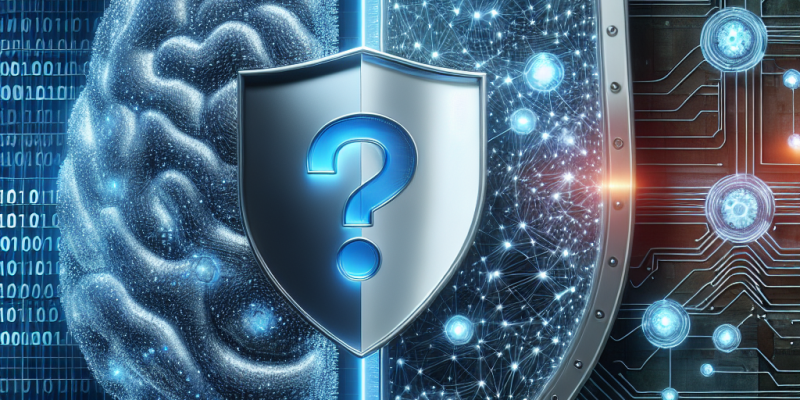Artificial Intelligence in Cybersecurity: Friend or Foe?

As we plunge deeper into the digital age, the overlap between artificial intelligence (AI) and cybersecurity becomes increasingly significant. The advent of AI has not only revolutionized how businesses operate but has also introduced an array of challenges and opportunities in securing digital environments. As we navigate these developments, it is crucial to assess whether AI is primarily a friend or a foe in the realm of cybersecurity.
The Role of AI in Cybersecurity
1. Enhanced Threat Detection
One of the most promising applications of AI in cybersecurity is its ability to enhance threat detection. Traditional security measures often rely on signature-based detection, which can miss emerging threats. AI, on the other hand, employs machine learning algorithms to analyze vast amounts of data, identifying patterns and anomalies that may indicate a security breach.
For instance, modern AI systems can be trained to recognize the behaviors of known threats and then apply that knowledge to detect new, previously unseen threats. This proactive approach significantly reduces response times and helps organizations mitigate potential damages before a breach can occur.
2. Automated Response
AI in cybersecurity is not limited to detection; it can also enable automated responses to identified threats. Automated systems can react to incidents much faster than human operators, isolating affected systems, blocking malicious traffic, and even initiating incident response protocols in real time. This capability is especially crucial in a landscape where cyber attacks are increasingly sophisticated and occur within milliseconds.
3. Predictive Capabilities
AI can also enhance predictive capabilities, allowing organizations to assess potential vulnerabilities before they are exploited. By analyzing historical data and threat intelligence, AI can forecast likely attack vectors, helping companies reinforce their defenses proactively. This forward-thinking approach is a significant evolution from reactive cybersecurity strategies that merely respond to incidents after they occur.
The Dark Side of AI in Cybersecurity
While AI presents remarkable advantages, it is not without its pitfalls. Adversaries are increasingly leveraging AI tools to enhance their attacks, leading to a new dimension of cybersecurity challenges.
1. Sophisticated Attacks
Cybercriminals are adopting AI-driven techniques to automate and enhance their attacks. For instance, they can employ machine learning to create more convincing phishing emails, essentially personalizing attacks at scale. Automated bots can mimic legitimate user behavior to bypass traditional security measures, increasing the risk of successful breaches.
2. Data Poisoning
AI systems rely on vast datasets for training and functioning, making them susceptible to data poisoning. Attackers can manipulate the training data to skew an AI model’s results, which can lead to misclassification of threats or even the creation of vulnerabilities in the system itself. This vulnerability emphasizes the need for rigorous data oversight in AI applications.
3. False Positives and Negatives
Despite their advancements, AI systems are not foolproof. They can produce false positives, which may lead to unnecessary alarm and operational disruptions, or false negatives, where actual threats go undetected. This inconsistency can undermine the reliability of AI-driven security systems, complicating incident response efforts.
The Future: Coexistence and Collaboration
As we look ahead, the future of AI in cybersecurity may not strictly categorize it as a friend or a foe. Instead, a balanced coexistence where AI systems complement human expertise may prove most effective.
1. Human-AI Collaboration
Integrating AI into existing cybersecurity frameworks will require a hybrid approach, where human analysts work alongside AI systems. While AI can process data at remarkable speeds, human intuition and experience are invaluable for contextualizing threats and devising strategic responses.
2. Ethical Considerations
A key challenge moving forward will be establishing ethical frameworks governing the use of AI in cybersecurity. As AI systems become more autonomous, they inherently introduce risks related to accountability and transparency. Organizations must navigate these challenges while embracing innovation that strengthens their cybersecurity posture.
Conclusion
Artificial intelligence stands as both an ally and a potential adversary in the complex domain of cybersecurity. Its ability to enhance threat detection, automate responses, and predict future vulnerabilities renders it a powerful tool against cyber threats. However, as malicious actors also harness AI in their attacks, the challenge intensifies.
Ultimately, the efficacy of AI in cybersecurity will depend on our ability to leverage its strengths while acknowledging and counteracting its weaknesses. Through collaboration, ethical considerations, and continued innovation, we can navigate this evolving landscape and harness AI as a pivotal component in the fight against cyber threats.














